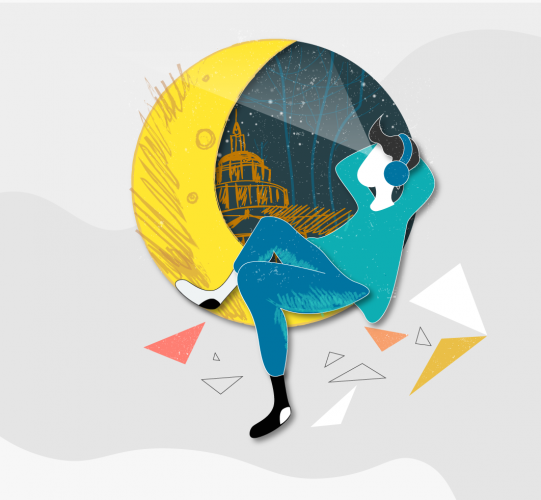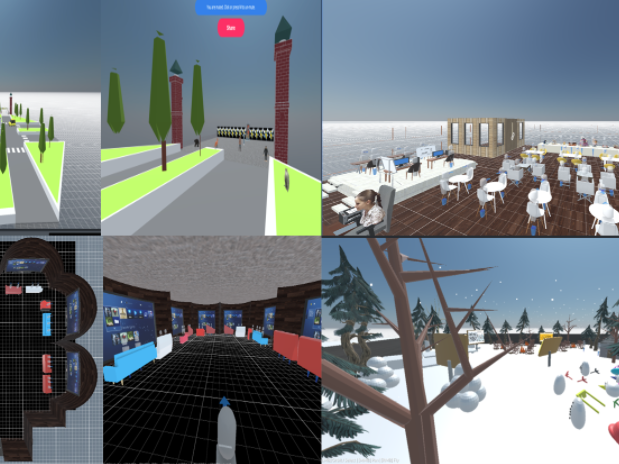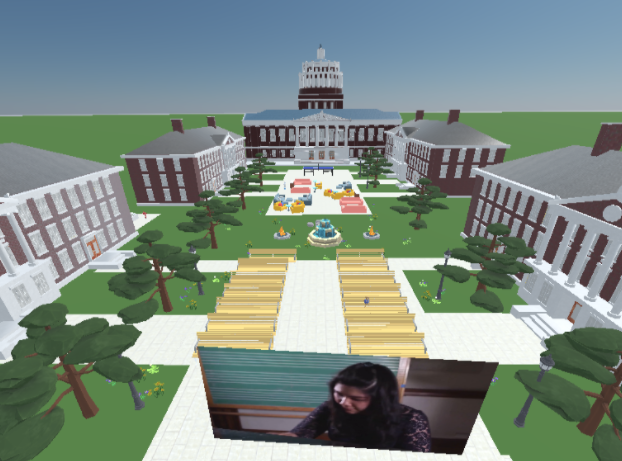
Last summer, COVID-19 safety protocols made most of the University’s River Campus a desolate, lonely place. There were tumbleweeds indoors. (We don’t know for sure because we weren’t there due to the closure, but given the state of the world, it seems possible.) A Rochester student, who, presumably, had grown tired of the lack of social and study spaces available in real life, threw out the question, “What does virtual reality have to offer?”
The result of that pandemic-fatigued student’s inquiry was the Dream University Challenge. Throughout the better part of this month, the River Campus Libraries’ Barbara J. Burger iZone and Studio X, with support from the Hajim School of Engineering & Applied Sciences, led a competition that had students imagining, designing, and building virtual University of Rochester spaces that would provide them and their peers with opportunities to connect.
“You just couldn’t have those happenstance interactions,” says Emily Sherwood, director of Digital Scholarship and Studio X, of campus life under COVID-19. “We thought, ‘Students know the types of spaces they want; what if we gave them a hackathon-style challenge to create them?’”
Believe it or not, not all Rochester students have the innate skills to build virtual worlds. To make the challenge more welcoming to those without VR experience, Mozilla Hubs, a user-friendly virtual reality platform, was used. On top of that, the challenge had built-in design thinking and technical workshops to help participants bring their ideas to life.
When the challenge kicked off on January 7, two teams, UR Haven and Dream Rush Rhees, set out to build dream spaces in just seven days.
What transpired can’t really be called competitive because it connotes a level of rivalry that just wasn’t there. The relatively small number of participants—most of whom didn’t know each other—and the challenge’s interactive phases and collaborative spirit made this more of an educational bonding experience than a competition.
“I think we had a unique group of students who were interested in figuring out ways to connect with each other,” Sherwood says. “They’re coming out of this really exhausting semester thinking, ‘We still want to connect; we still want to learn things; we still want opportunities to have these conversations.”
Connecting may have been the primary objective for UR Haven’s Sophea Urbi Biswas ʼ23, an international student from Bangladesh. Before joining the challenge, she was concerned about the various effects the distance could have on her, like losing some of her fluency in English or becoming socially and culturally detached.
“The more I stay integrated with the community, the more I feel like I belong there,” Biswas says. “It's kind of hard to be in a totally different country and feel like you're part of a university. It feels like you're just a name on paper. So I always wanted a virtual space where I could get to interact with people and have informal conversations and just talk about life.”
Sherwood also highlights the challenge’s size, noting that everyone got to know everyone, including those on the other team. Dream Rush Rhees member Carolina Lion He ʼ21 felt the chance to meet new people and hear the creativity of her peers was the “amazing part of this challenge.”
“At first, I thought it was going to be very competitive,” He says. “But everyone was just so friendly. The UR Haven team was really, really nice. It reminds me why I chose the University of Rochester. You know, that entire Meliora, ever better—it’s real.”
The whole purpose of this challenge was to facilitate student connections. From that perspective, there are only winners here. From the perspective this was a competition, there was a team whose dream space was deemed the best overall.
Here’s a look at each team, their space, and what the judges had to say.
UR Haven—WINNER

Team members
- Sophea Urbi Biswas ʼ23, biomedical engineering
- Joey Chan ʼ23, digital media studies
- Koshala Mathuranayagam ʼ23, biomedical engineering
- Miguel Yakouma ʼ23, biomedical engineering
Their space
There’s a lot to see. You’re dropped in a sort of VR green room, populated most notably by Pee-wee Herman. Follow the purple arrows to enter UR Haven’s playhouse, into a café area where Pharrell Williams’s “Happy” plays on a jukebox and the sitcom Friends is playing on a TV. From here, you can go to the Clover Room, a three-leafed clover-shaped theatre space, or Winter Wonderland, a snowy area that allows you to build snow people and snow castles or have a snowball fight. Explore the space.
Judge commentary
“These spaces are fantastic! I loved the different feel of the rooms. The architecture of the theater room was really interesting. I like the clover design that allows some privacy for the different viewing areas. The [Winter Wonderland] area was also amazing. I loved how you added in signs that provided information on how to participate in each "station," and I really liked the idea that the rule for one of the games is to say hi to someone near you-- what a great way to ensure participants meet each other and interact! The dining area felt like a Douglass Dining Hall type of space, and I think this could really attract students who want to find others to hang out with. The use of arrows was a smart way to guide the participant through the spaces.”
Dream Rush Rhees

Team members
- Debamitra Chakraborty, third-year graduate student in materials science
- Siladitya Khan ʼ20 (MA), doctoral student in biomedical engineering
- Carolina Lion He ʼ21, digital media studies
- Sydney Santiago, brain and cognitive sciences
The space
Enter Dream Rush Rhees, and you will find yourself in a furnished patio space on the Eastman Quad, replete with sofas and armchairs. At one end, there’s a ping pong table; at the other end, a drive-in-movie-style screen playing an interview with Edith Widayni, a doctoral candidate at the Eastman School of Music, and in between, a stately fountain. You’ll also find a groundboi and quadfox hanging around. Explore the space.
Judge commentary
“This is a beautiful space that makes the participant really feel like they are back on campus. The chairs are welcoming, and the video at one end of the quad is a really nice touch. Seeing the Rush Rhees library and other buildings on the quad creates a feeling of ‘home.’” ∎
You can read more on the challenge’s results and each team’s space, including notes on their design, in the Studio X blog. For more information on the challenge itself or Studio X, contact Emily Sherwood, director of Digital Scholarship and Studio X, at esherwood@library.rochester.edu. Enjoy reading about the University of Rochester Libraries? Subscribe to Tower Talk.

